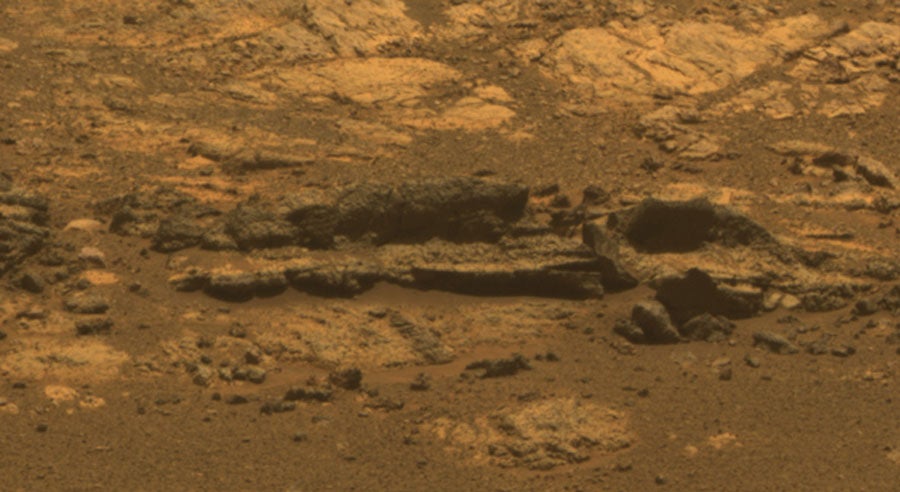The site, called Matijevic Hill, overlooks the 14-mile-wide (22 kilometers) Endeavour Crater. Opportunity has begun investigating the site’s concentration of small spherical objects reminiscent of, but different from, the iron-rich spheres nicknamed “blueberries” at the rover’s landing site nearly 22 driving miles ago (35km).
The small spheres at Matijevic Hill have different composition and internal structure. Opportunity’s science team is evaluating a range of possibilities for how they formed. The spheres are up to about an eighth of an inch (3 millimeters) in diameter.
The “blueberries” found earlier are concretions formed by the action of mineral-laden water inside rocks, but that is only one of the ways nature can make small, rounded particles. One working hypothesis, out of several, is that the new-found spherules are also concretions but with a different composition. Others include that they may be accretionary lapilli formed in volcanic ash eruptions, impact spherules formed in impact events, or devitrification spherules resulting from formation of crystals from formerly melted material. There are other possibilities, too.
“Right now, we have multiple working hypotheses, and each hypothesis makes certain predictions about things like what the spherules are made of and how they are distributed,” said Steve Squyres from Cornell University in Ithaca, New York. “Our job as we explore Matijevic Hill in the months ahead will be to make the observations that will let us test all the hypotheses carefully, and find the one that best fits the observations.”
The team chose to refer to this important site as Matijevic Hill in honor of Jacob Matijevic (1947-2012), who led the engineering team for the twin Mars Exploration Rovers Spirit and Opportunity for several years before and after their landings. He worked at NASA’s Jet Propulsion Laboratory in Pasadena, California.
The site, called Matijevic Hill, overlooks the 14-mile-wide (22 kilometers) Endeavour Crater. Opportunity has begun investigating the site’s concentration of small spherical objects reminiscent of, but different from, the iron-rich spheres nicknamed “blueberries” at the rover’s landing site nearly 22 driving miles ago (35km).
The small spheres at Matijevic Hill have different composition and internal structure. Opportunity’s science team is evaluating a range of possibilities for how they formed. The spheres are up to about an eighth of an inch (3 millimeters) in diameter.
The “blueberries” found earlier are concretions formed by the action of mineral-laden water inside rocks, but that is only one of the ways nature can make small, rounded particles. One working hypothesis, out of several, is that the new-found spherules are also concretions but with a different composition. Others include that they may be accretionary lapilli formed in volcanic ash eruptions, impact spherules formed in impact events, or devitrification spherules resulting from formation of crystals from formerly melted material. There are other possibilities, too.
“Right now, we have multiple working hypotheses, and each hypothesis makes certain predictions about things like what the spherules are made of and how they are distributed,” said Steve Squyres from Cornell University in Ithaca, New York. “Our job as we explore Matijevic Hill in the months ahead will be to make the observations that will let us test all the hypotheses carefully, and find the one that best fits the observations.”
The team chose to refer to this important site as Matijevic Hill in honor of Jacob Matijevic (1947-2012), who led the engineering team for the twin Mars Exploration Rovers Spirit and Opportunity for several years before and after their landings. He worked at NASA’s Jet Propulsion Laboratory in Pasadena, California.










